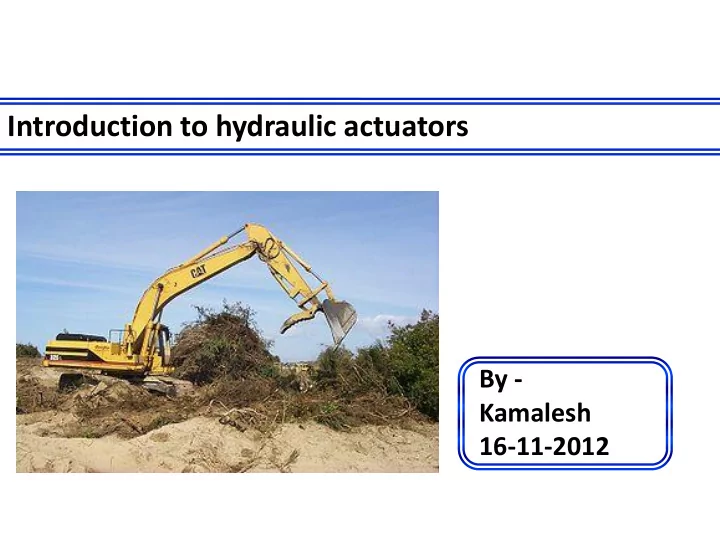

Introduction to hydraulic actuators By - Kamalesh 16-11-2012
History and definition Inventor Joseph Bramah of England invented Hydraulic press and was issued a patent on this press in 1795. Pressurized hydraulic fluid used to transfer energy from flow and pressure to drive hydraulic machinery. 01
Principle of hydraulic system Pascal's law is the basis of hydraulic drive systems. 02
Basic hydraulic system Hydraulic jack 03
Hydraulic actuators 1. Hydraulic motors 2. Hydraulic cylinders 04
Hydraulic motors A hydraulic motor is a mechanical actuator that converts hydraulic pressure and flow into torque and angular displacement (rotation). 05
Hydraulic cylinders A Hydraulic cylinder (also called a linear hydraulic motor) is a mechanical actuator that is used to give a unidirectional force through a unidirectional stroke. Single acting vs. double acting 1. Single acting cylinders are economical and the simplest design. Hydraulic fluid enters through a port at one end of the cylinder, which extend the rod by means of area difference. An external force returns or gravity returns the piston rod. 2. Double acting cylinders have a port at each end, supplied with hydraulic fluid for both the retraction and extension. 06
Components of a hydraulic cylinder 1. Cylinder barrel 2. Cylinder base or cap 3. Cylinder head 4. Piston 5. Piston rod 6. Seal gland 7. Seals (nitrile rubber, Polyurethane or Fluorocarbon Viton) 07
Cylinder designs Telescopic cylinder These are multistage cylinders which can fit in the smaller dimensions of machine. Plunger cylinder An hydraulic cylinder without a piston or with a piston without seals is called a plunger cylinder. Differential cylinder A differential cylinder acts like a normal cylinder when pulling. If the cylinder however has to push, the oil from the piston rod side of the cylinder is not returned to the reservoir, but goes to the bottom side of the cylinder. In such a way, the cylinder goes much faster, but the maximum force the cylinder can give is like a plunger cylinder. 08
Cylinder designs Rephasing cylinder Rephasing cylinders are two or more cylinders plumbed in series or parallel, mainly for synchronization. Position sensing "smart" hydraulic cylinder 09
Force of hydraulic cylinder The pushing or pulling force of a hydraulic cylinder is as follows: F = Ab * pb - Ah * ph F = Pushing Force in N Ab = ( π/ 4) * (Bottom-diameter)^2 [in m2] Ah = ( π/ 4) * ((Bottom-diameter)^2-(Piston-rod-diameter)^2)) [in m2] pb = pressure at bottom side in [N/m2] ph = pressure at cylinder head side in [N/m2] 10
Benefits of hydraulic system 1. A small force can be transformed to large force. 2. Linear force can be achieved by hydraulic cylinders in better way. 3. Transfer of force is easy. 11
Thank you
Recommend
More recommend